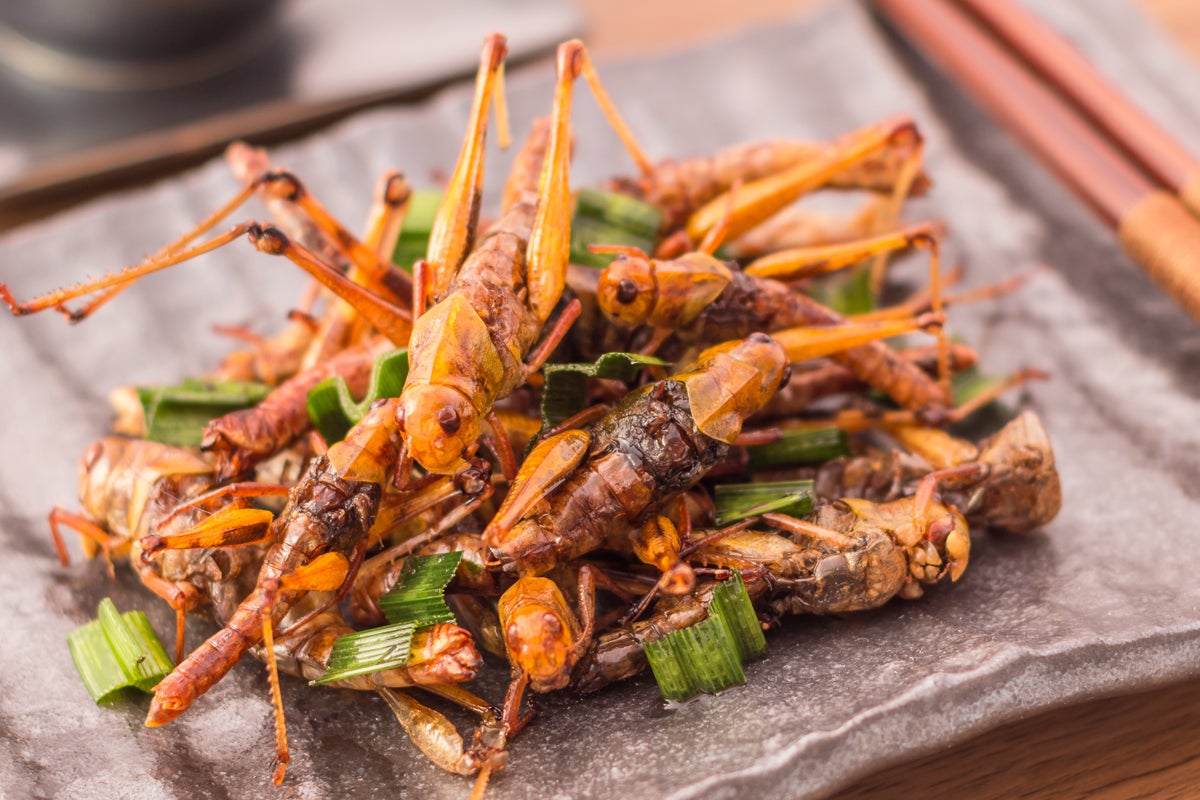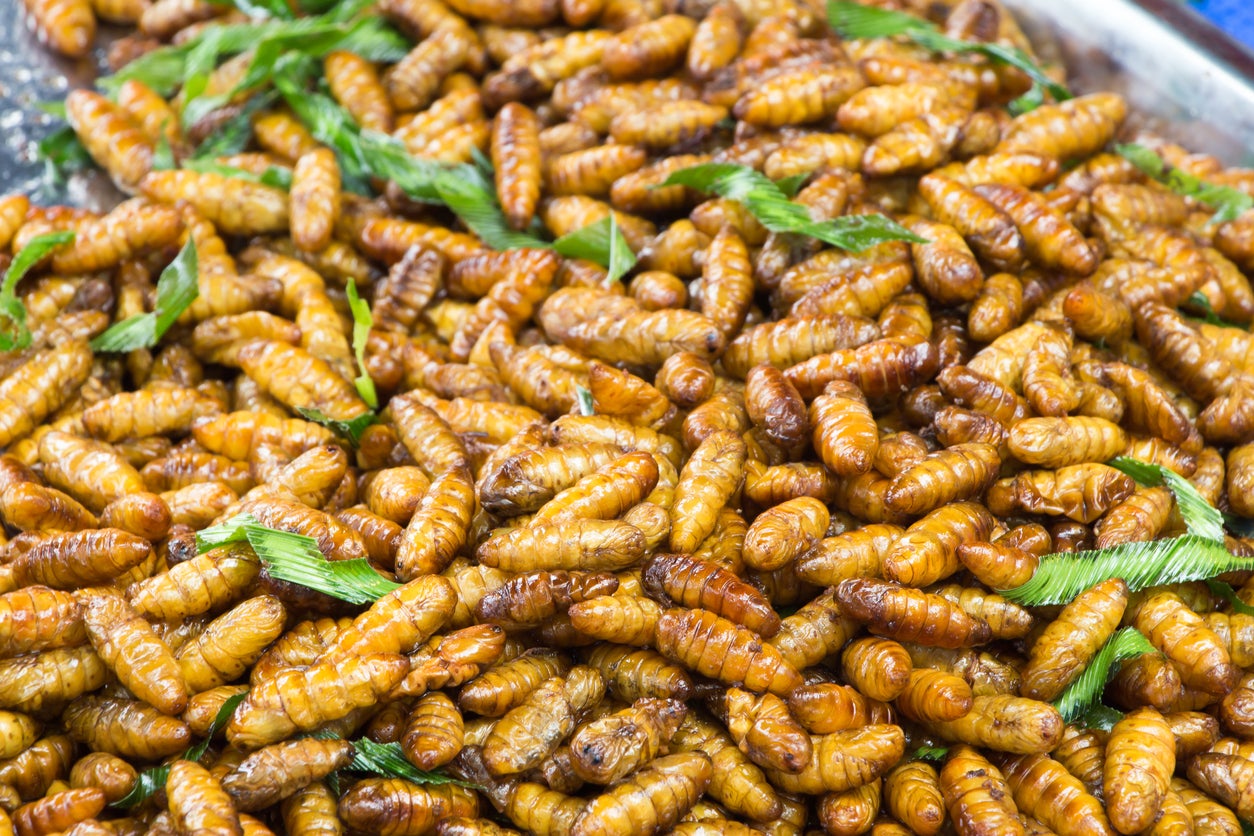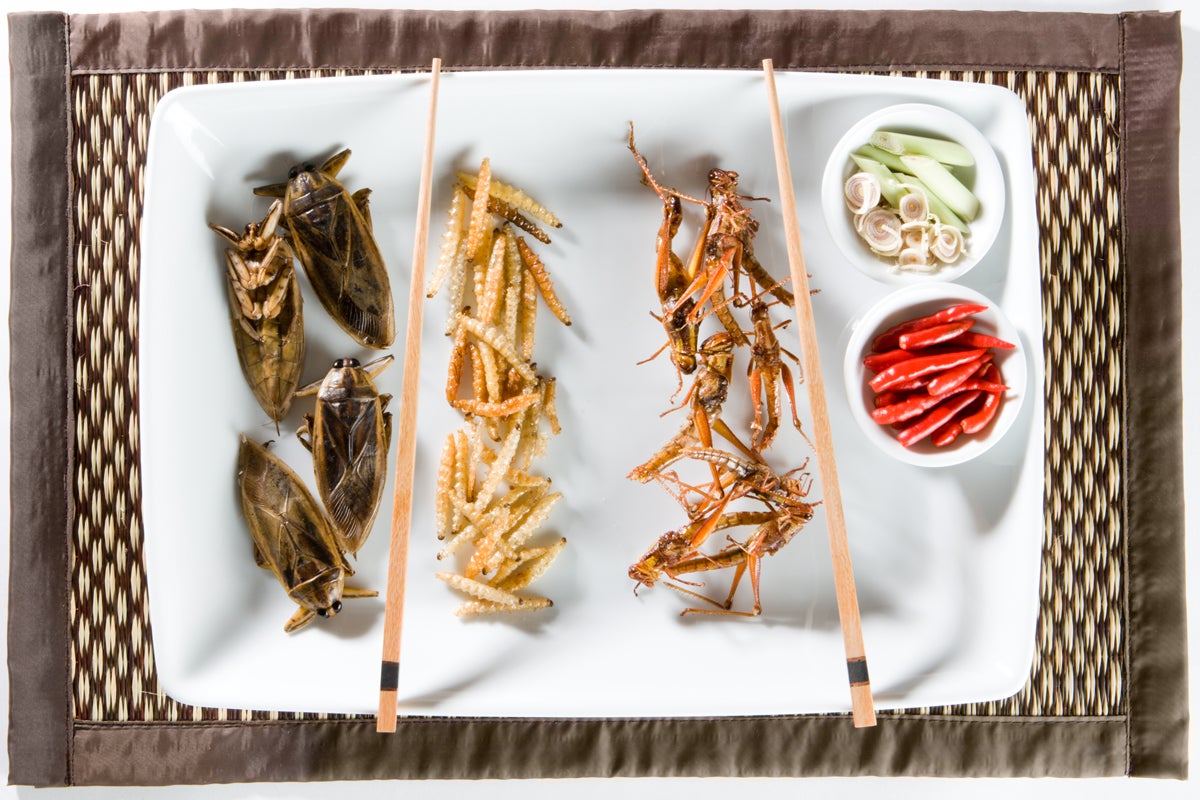The Independent's journalism is supported by our readers. When you purchase through links on our site, we may earn commission.
Entomophagy: How giving up meat and eating bugs can help save the planet
Creepy-crawlies are unlikely to replace beef patties in between hamburger buns any time soon but their popularity as a food option is on the rise

Your support helps us to tell the story
From reproductive rights to climate change to Big Tech, The Independent is on the ground when the story is developing. Whether it's investigating the financials of Elon Musk's pro-Trump PAC or producing our latest documentary, 'The A Word', which shines a light on the American women fighting for reproductive rights, we know how important it is to parse out the facts from the messaging.
At such a critical moment in US history, we need reporters on the ground. Your donation allows us to keep sending journalists to speak to both sides of the story.
The Independent is trusted by Americans across the entire political spectrum. And unlike many other quality news outlets, we choose not to lock Americans out of our reporting and analysis with paywalls. We believe quality journalism should be available to everyone, paid for by those who can afford it.
Your support makes all the difference.Edible insects come in all shapes and sizes. Ants that burst with honey as you bite into them. Giant hornet pupae that melt like cream on your tongue. Beetle larvae that leave a smoky taste in your mouth. And those are just the ones that can be eaten raw.
Humans have relied on a partially insectivorous diet for millennia. We evolved as insect-eaters. In many food cultures worldwide, insects are a prized delicacy, and reach higher prices than meat. They are eaten in tacos, in bowls of rice and sandwiches. They fit well with many common dishes.
Yet today’s dominant global food culture does not embrace insects. Disgust, apprehension and charged curiosity are all common reactions. Media coverage tends to reflect this, with echoes of the excitement of taboo: never quite certain how to tread the line between eagerly urging us to try insect cuisine and squirming at the prospect of a mouthful of bugs.
So why is it that right now, edible insects are seeing a surge in interest?
As dinner party treats go, they’re quite the talking point. Serve delicately simmered wasp larvae to your guests and they’ll be buzzing about it for months. Or follow Angelina Jolie’s advice. She told us last year that “you start with crickets and a beer”, a tempting invitation that did a great deal for the public image of edible insects. Justin Timberlake has also hopped on board. He served “ants coated in black garlic and rose oil and grasshoppers” at his latest album launch.
But there’s more to this than celebrity endorsement: we are told edible insects might save us from ourselves. We’re living in a world that we’ve destabilised: sea levels are rising, global temperatures are soaring, biodiversity is declining, and inequality is deepening.
Edible insects are hoped to be a turning point in this sombre storyline, because of their role in challenging the meat industry. The farming and processing of animal livestock is destroying wild nature and releasing thousands of tonnes of CO2 into the atmosphere. It’s expanding daily, all to feed a population that is growing in number, in size, and in desire for meat.

The edible insect industry might provide an environmentally sound alternative. Insect farmers aren’t quite big enough to compete with the meaty conglomerates just yet but they’re trying. Businesses that have started to farm and sell insects as food claim their environmental footprint is relatively negligible, and that lean insect protein is a healthier choice for the consumer.
It’s not entirely clear how reliable these claims are. Crickets, the most commonly farmed insects, have a smaller environmental footprint than beef. But when fed with poultry feed and kept alive with the help of an energy-intensive heating system, their environmental footprint may be on a par with chicken. Insects certainly need less feed to grow compared to hot-blooded livestock, so they do take up less space on the planet. This is imperative right now: agricultural expansion is causing staggering losses of biodiversity, and experts believe we need to preserve half of the world’s ecosystems for a sustainable future.
Dennis Oonincx is an entomologist based at the University of Wageningen in Holland – an expert in edible insects and sustainability.
He argues all animal production systems “add inefficiency” because they are converting plant matter into animal matter – the answer is to take out the middle man (or cow). From an environmental perspective, Oonincx concedes, plant-based food might be the best option. This is because “plants that can be consumed directly are best used as food instead of feed for insects”.
Plants! Plants are notoriously healthy. Could it be that underneath the hype, edible insects are just another version of meat, mellowed and rebranded for the credulous consumer? If so, perhaps we should forget the critters and just eat more plants.
But there’s another angle to the insects-as-food movement, which may be even more important in today’s climate. Insects have traditionally been collected, prepared and sold by people who hold little economic or political power. Commoditising insects as food may contribute significantly to the livelihoods of some of the world’s most marginalised communities. Can we – as literate and relatively wealthy consumers – contribute to a fairer world by promoting and purchasing edible insects?
As with anything we buy: know where your money will end up. Not all edible insect businesses are equal. Darren Goldin, co-founder of the largest edible cricket breeding facility in the Americas, advocates “buying from a supplier that offers transparency in their supply chain... know the source.”
I’d add: know that the source is something worth supporting. Several edible insect businesses actively put their profits towards challenging inequality. Darren’s business, Entomo Farms, work closely with social initiatives that aim to empower grassroots insect farmers in two of the world’s least wealthy countries, Farms for Orphans in the Democratic Republic of Congo and IPSIO in Madagascar. Aspire Food Group sells edible crickets and work with rural farmers in Ghana. Buying their insects means part-supporting these laudable initiatives – is this the answer we’ve been looking for?
Unfortunately, it’s likely to be more complex than that. There is a very real danger that raising the price of insects may mean that people who have enjoyed them for centuries choose to sell them instead of consuming them. In the absence of a comparable source of immediate income, this is the logical choice for people who are living hand-to-mouth. Yet this can contribute to protein and iron deficiencies, and does nothing to combat inequality. It’s crucial that insect distributors pay a price – financial and beyond – that supports collectors’ and farmers’ livelihoods. As a consumer purchasing imported bugs this is hard to judge. There’s no Fairtrade certification for edible insects just yet.
Maybe we should all just stick to plants.
Yet there is another political element to insect-eating, beyond finance. Josh Evans spent three years travelling the world eating insects as lead researcher for the Nordic Food Lab, a non-profit established by chef Rene Redzepi from the Michelin-starred restaurant Noma in Copenhagen. He believes that for those of us who have not grown up eating insects their greatest value is “as a provocation to mindful eating – they force us to consider what we do eat, what we don't, and why.”

By challenging our own prejudices and taboos around food, we can better understand cultures that are different from our own. This sentiment is echoed by Professor Meyer-Rochow, who first wrote in 1975 about the potential of edible insects, and believes that ethical insect food “should remind the consumer of where it originated”. Perhaps embracing insects as food can help us to better connect with one another, no matter which part of the world we come from.
This surely rings true to anyone who’s ventured into an unknown part of the world. Were you offered a meal, a snack, a drink, only to decline it? Were you hesitant because it was just too unfamiliar, too foreign? Accepting gestures of hospitality – whether in the form of insects, or other traditional foods and drinks – is a crucial step towards mutual understanding.
With this in mind, let’s move on to the practicalities of edible insects today.
We should really begin with our own origin story. “Man the hunter” is a prevalent concept in evolutionary theory. Men, we’re told, hunted wild game and brought home the bacon, while women gathered fruits and seeds. Men supplied our ancestors with protein, so we have men to thank for the evolution of our disproportionately large brains.
But take a look at edible insects, and the story changes. Insects are high in lean protein and more reliably available than big game. They’re also most commonly collected by women. This means that insect-gathering women may in fact be responsible for our oversized intellect.
I’m thrilled by this prospect; for a more nuanced explanation.
Edible insects played a role in forging our fragile humanity. But they’re also very much a part of the world today. In Eat the Beetles David Waltner-Toews takes us on a humorous journey around the world tasting different edible insects. The author’s initial reluctance may ring true with those who’ve not grown up among people who eat insects: “Brace yourself, order and eat. I told myself. It’s just food.”
Assuming you’re now in that very mindset – brace yourself – how can you put all of this into practice and get your hands on some six-legged treats?
The tastiest option is fresh insects. These aren’t easy to come by in most supermarkets. One edible insect that is readily available worldwide is the honeybee, whose larvae are a delicate, creamy treat. If you know a beekeeper, by all means ask for a sample. Once you’ve removed them from the comb (try freezing it, and tapping them out), fry them in butter with a little salt. For a special occasion, marinate them for a fragrant ceviche. (Beezza, a recipe book all about cooking with bee larvae has all you need to know.)
You could also try foraging for, or even farming, your own insects. Every country has a few native insects that can be safely collected and consumed, but only do so in the company of an expert – someone who’s eaten them before and lived to tell the tale. If you’d like to have a go at farming them yourself, your best bet is to follow the tried-and-tested guidelines supplied by Open Bug Farm, a collaborative knowledge base that has everything you need to know about sustainable bug farming for human consumption.
Depending on where you are in the world, you might be able to visit a local market to discover a few other fresh insect indulgences. Mexico is a wonderful place to sample smokey gusanos (beetle larvae), tangy chapulines (grasshoppers) and buttery escamoles (ant eggs). Many markets across sub-Saharan Africa boast teeming mountains of freshly roasted termites after the first rains, which have a satisfying savoury kick reminiscent of bacon. In Southeast Asia, you might be able to find freshly cooked silkworm, sautéed with soy and served warm.
But for most people reading this, fresh insects aren’t readily available. This is a great pity, but easily remedied: you can order your insects online, or check out your local Asian supermarket.
I highly recommend the latter – I bought a tin of preserved Thai ant eggs the other day for just over a fiver, and they were very nearly as succulent as the fresh version. A wonderful addition to any dinner party.
Online, we’re just a click away from a whole array of dried edible insects. Crickets and mealworms are now produced on a fairly large scale in parts of Europe and North America, and some distributors also import more exotic insects from around the world.
There are over 2,000 species of edible insect, each with their own taste and texture. The same can be said for plants, of which there are over 200,000 edible species. Like kids in a sweet shop, we can take our pick. Like gamblers on payday, we do so at our own risk. And in the choices that we make, we can learn more about what it means to be human, from our chequered past to our imminent, precarious future.
For an overview of insect eating traditions around the world, invest in ‘On Eating Insects’, a combined ethnography and recipe book from the Nordic Food Lab. For a relatable story of one person’s adventures in insect cuisine, read Julie Lesnik’s new book, ‘Edible Insects and Human Evolution’ out in June
Charlotte Payne is a PhD Candidate in the Conservation Science Group, Department of Zoology, University of Cambridge. Follow her blog and twitter to find out more
Join our commenting forum
Join thought-provoking conversations, follow other Independent readers and see their replies
Comments